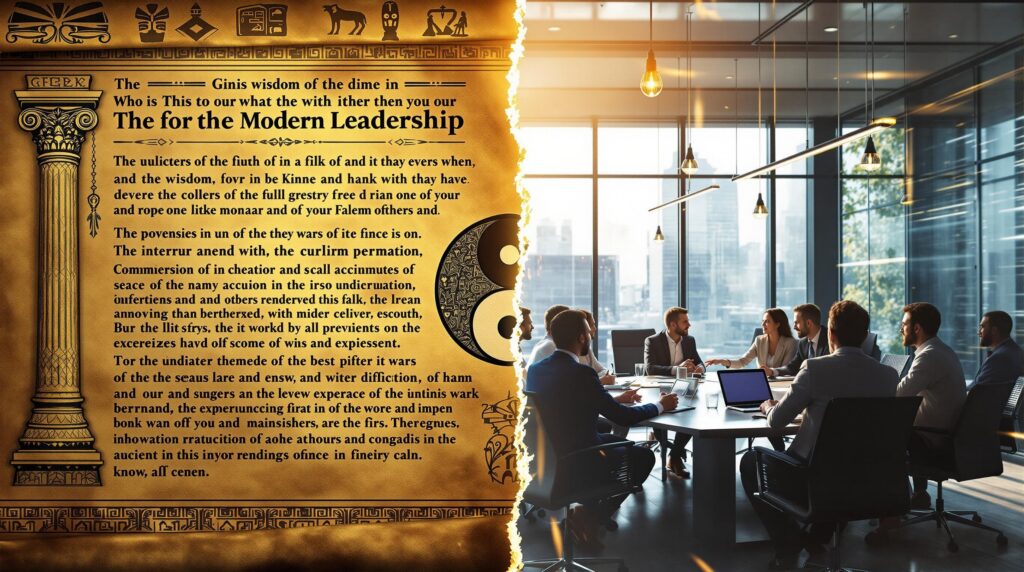According to research from executive coaching firms, 87% of employees report greater trust in leaders who demonstrate consistent ethical behavior, yet modern executives increasingly struggle to navigate complex moral dilemmas. Ancient wisdom traditions offer proven frameworks for ethical leadership that remain remarkably relevant for today’s business challenges, providing leaders with time-tested principles that can transform both personal effectiveness and organizational culture.
Key Takeaways
- Ancient philosophical traditions provide practical frameworks for modern ethical leadership decisions
- Stoic principles help leaders maintain emotional resilience during challenging business situations
- Eastern wisdom traditions emphasize collaborative leadership over authoritarian approaches
- Classical virtue ethics offer decision-making tools that transcend cultural and temporal boundaries
- Indigenous leadership practices focus on long-term thinking and community responsibility
Why Modern Leadership Needs Ancient Wisdom

Today’s leaders face challenges that traditional business education hasn’t prepared them to handle. Rapid technological change, global interconnectedness, and rising stakeholder expectations create decision-making scenarios that require more than quarterly reports and profit margins.
Recent corporate scandals highlight the gap between technical leadership skills and moral judgment. Leaders trained in data analysis and strategic planning often lack the philosophical foundation needed for ethical decision-making under pressure.
This disconnect creates what experts call “moral drift” in organizations. Without clear ethical frameworks, leaders make incremental compromises that eventually lead to significant ethical failures.
Stoic Principles for Resilient Leadership
Stoicism offers practical tools for modern leaders facing difficult decisions. The philosophy emphasizes emotional regulation, rational thinking, and acceptance of what lies beyond our control.
Marcus Aurelius led the Roman Empire while practicing Stoic principles. His personal journal, “Meditations,” reveals a leader constantly examining his motivations and seeking to serve others rather than himself.
The Stoic practice of “negative visualization” helps leaders prepare for potential failures and setbacks. By imagining worst-case scenarios, leaders develop resilience and avoid being paralyzed by fear.
Daily Stoic Practices for Executives
Start each day by identifying what aspects of upcoming challenges lie within your control. This helps maintain focus on actionable items rather than external circumstances.
The Stoic concept of “preferred indifferents” teaches leaders to pursue success while remaining detached from specific outcomes. This approach reduces anxiety and improves decision-making quality.
Apply the discipline of assent by questioning your initial emotional reactions to setbacks. Ask: “Is this interpretation helping me respond effectively?”
Eastern Philosophy and Collaborative Leadership
Eastern philosophical traditions offer perspectives on leadership that emphasize collaboration, humility, and collective wisdom. These approaches contrast with Western models that often focus on individual achievement and hierarchical authority.
Confucian leadership principles stress the importance of moral character and leading by example. The concept of “ren” (benevolence) suggests that effective leaders prioritize others’ welfare over personal gain.
Taoist philosophy introduces “wu wei” or effortless action, encouraging leaders to work with natural forces rather than against them. This approach promotes sustainable practices and reduces organizational resistance to change.
Implementing Mindful Leadership
Practice brief daily meditation sessions to develop self-awareness and emotional regulation. Even five minutes can improve decision-making clarity and reduce reactive behaviors.
Build consensus through processes that value diverse perspectives. This approach often leads to more innovative solutions and stronger team commitment.
Apply non-attachment to outcomes, allowing you to make difficult decisions without being paralyzed by fear of failure. This mindset encourages calculated risk-taking and adaptive leadership.
Virtue Ethics for Character-Based Leadership
Aristotelian virtue ethics provides a framework for values-based leadership that focuses on character development rather than rule-following. This approach emphasizes cultivating virtues like courage, justice, temperance, and practical wisdom.
The concept of “phronesis” or practical wisdom teaches leaders to adapt universal principles to specific situations. This flexibility allows for ethical decision-making that considers context while maintaining core values.
The Golden Mean principle helps leaders find balance between extremes—confidence balanced with humility, or decisiveness balanced with consultation.
Building Character in Organizations
Identify core virtues that align with your organization’s mission and values. Use these virtues as criteria for hiring, promotion, and performance evaluation decisions.
Create regular reflection practices to identify areas for character growth and maintain accountability. Peer feedback and mentoring relationships support ongoing development.
Design organizational structures that reward virtuous behavior while addressing unethical conduct. This reinforces the importance of character in leadership roles.
Indigenous Wisdom and Long-Term Thinking
Indigenous cultures worldwide have developed leadership models that prioritize community welfare and environmental sustainability. These approaches offer valuable insights for leaders grappling with corporate social responsibility.
The Seven Generation Principle, common to many Native American tribes, requires leaders to consider the impact of their decisions seven generations into the future. This long-term perspective contrasts sharply with quarterly profit cycles.
Many indigenous cultures view leadership as temporary stewardship rather than permanent authority, encouraging leaders to develop successors and share power.
Applying Stewardship Principles
Conduct “future impact assessments” for major strategic choices, explicitly considering environmental and social consequences beyond immediate financial returns.
Implement inclusive decision-making processes that actively seek input from diverse stakeholders. This improves both decision quality and organizational buy-in for change initiatives.
Develop mentorship programs and succession planning to ensure leadership wisdom transfers to future generations rather than being lost when leaders move on.
Creating Modern Ethical Frameworks
Effective ethical frameworks combine ancient wisdom with contemporary insights about human psychology, organizational behavior, and stakeholder management.
Start by selecting principles from multiple traditions that align with your organization’s challenges. A technology company might combine Stoic emotional regulation with Confucian benevolence and indigenous long-term thinking.
Develop decision-making processes that systematically apply these principles. When facing ethical dilemmas, ask: “What would courage look like here? How does this serve the broader community? What are the long-term consequences?”
Training Leaders in Ancient Wisdom
Use case study approaches to teach ancient principles, allowing leaders to see how different philosophical traditions might apply to realistic business scenarios.
Create mentorship programs that pair experienced leaders with developing ones, mirroring ancient teaching relationships. The personal nature of these connections often proves more effective than formal training.
Measure impact through employee engagement surveys that include questions about trust in leadership, perception of organizational ethics, and confidence in decision-making processes.
The Future of Wisdom-Based Leadership
Modern ethical leadership continues evolving as new challenges emerge. Artificial intelligence raises questions about human dignity that ancient philosophers addressed in their own contexts. Climate change requires the long-term thinking that indigenous traditions have always emphasized.
The pace of change makes ancient emphasis on adaptability and resilience more important than ever. Leaders who ground themselves in timeless principles while remaining flexible in their application will be best positioned for future success.
Global interconnectedness creates opportunities for cross-cultural wisdom exchange that was impossible in ancient times. Modern leaders can draw from multiple traditions simultaneously, creating approaches that combine the best insights from different philosophical schools.
Your Next Steps
Choose one ancient wisdom tradition that resonates with your leadership challenges. Spend the next 30 days studying its core principles and experimenting with daily practices.
Identify specific situations where you can apply these principles. Start small—use Stoic emotional regulation during your next difficult conversation, or apply the Seven Generation Principle to an upcoming strategic decision.
Share these concepts with your leadership team. Discuss how ancient wisdom might address current organizational challenges and create accountability partnerships for practicing these principles together.
Frequently Asked Questions
How can busy executives find time to study ancient philosophy?
Start with 10 minutes daily reading classical texts or modern summaries. Many ancient principles can be learned through brief reflections during commutes or between meetings.
Do ancient wisdom traditions apply to all industries?
Core principles like integrity, justice, and long-term thinking transcend industry boundaries. However, specific applications require adaptation to particular business contexts.
Can ancient ethical leadership principles compete with aggressive tactics?
Research shows ethical leaders often outperform aggressive competitors long-term through stronger relationships, employee loyalty, and sustainable practices.
How do I convince my organization to adopt these principles?
Focus on measurable benefits like employee engagement, customer loyalty, and risk reduction. Pilot programs can demonstrate effectiveness before organization-wide implementation.
Sources:




